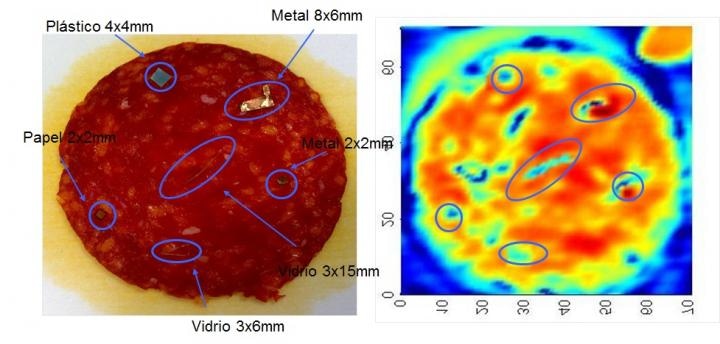Apr 3 2017
 Image obtained with this technology in which there can be seen, on a slice of sausage, plastics, metals and splinters of glass of different sizes and shapes. Credit: NUP/UPNA-Public University of Navarre
Image obtained with this technology in which there can be seen, on a slice of sausage, plastics, metals and splinters of glass of different sizes and shapes. Credit: NUP/UPNA-Public University of Navarre
Researchers have developed devices based on terahertz technology, referring to a band in the electromagnetic spectrum present between the infrared waves and the microwaves, which TVs and mobile phones need to function.
This terahertz band is considered to be the last unexplored region of the electromagnetic spectrum due to the complexity in generating and detecting waves of this type. However, the sensing of materials and substances is considered to be one of the fields in which huge technological potential is offered by terahertz. This is because of the fact that a characteristic footprint is displayed by almost all molecules on this band and this indeed permits them to the distinguished and identified.
"Seeing" inside substances
Terahertz radiation is capable of penetrating a huge range of objects and substances, so they make it possible to 'see' what is inside them. In the same way, the reflection of terahertz waves varies according to the material or body they impact upon, and this provides images depending on the power and phase of the wave received.
Juan Carlos Iriarte, Researcher, NUP/UPNA
The sensors produced in this project are initially used to identify foreign bodies existing in food products, such as vegetables and sliced meat. "Metals, including corrosion-resistant ones, paper, insects, plastics or glass can be found among these foreign bodies," pointed out the NUP/UPNA researcher. Secondly, it is possible to use these sensors to detect, in real time, microorganisms from the main, common pathogenic strains that could exist in perishable foodstuffs. This is followed by microorganism counts.
A device that is actually a miniaturized blend of a receiver and a transmitter has been designed by the researchers in this project. This new device takes on the task to detect the radiation reflected in the terahertz frequency range that is brought about by the chemical product or by a foreign body that one plans to study. "In the first case, that of a foreign body, the radiation is in proportion to its morphology, and, in the second, when a chemical product is involved, its molecular composition is obeyed allowing it to be unequivocally identified because each one has its own spectral radiation footprint," added Juan Carlos Iriarte. The authors of this research highlight that the detection is a lot simple and leads to less false alarms as the spectral signature of substances and objects is extremely different between one case and another.
The system for capturing images in terahertz constitutes a great advance in this field, as there are no similar devices devoted to inspection in the food sector, either nationally or internationally.
Juan Carlos Iriarte, Researcher, NUP/UPNA
The field of security is already using this terahertz-based technology to non-intrusively attain images of concealed weapons. The NUP/UPNA's Antennas Group is in fact actively involved in using this technological development in the sector.